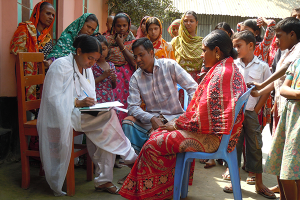In close consultation with technical and SBCC experts, design a strategy that describes the program’s overall vision, guiding principles, theoretical framework, strategic approach or positioning, and key audiences. The strategy should present communication objectives, key messages and communication channels by audience. All should be based on the formative research.
How to Develop a Communication Strategy
 The Health COMpass has a how-to guide on developing a communication strategy.
The Health COMpass has a how-to guide on developing a communication strategy.
Designing an SBCC Strategy I-Kit
 The Health Communication Capacity Collaborative developed an implementation kit on designing a social and behavior change communication strategy.
The Health Communication Capacity Collaborative developed an implementation kit on designing a social and behavior change communication strategy.
There are many ways to define audiences for an integrated campaign. Life stages is one approach, used in Egypt for the “Your Health is Your Wealth” campaign, and in Malawi for the “Life is Precious" campaign.
Life stages are times in a person’s life when they have particular health needs. For example, the “Life is Precious” campaign has four life stage audiences:
- Young married couples
- Parents of children under five years of age
- Parents of older children
- Adolescents
Usually, integrated campaigns have a number of elements, which the strategy should describe:
Introductory Campaign
An introductory campaign will familiarize audiences with the overall campaign theme and slogan, usually utilizing mass media and large-scale events.
Centerpiece or Cross-cutting Channels
Centerpiece or cross-cutting channels can communicate about a variety of health issues to the same audience over time. Examples of these are radio or television quiz shows or dramas; comic book or magazine series; booklets; social media; or websites. For example, the Good Life campaign in Ghana produced a weekly TV quiz show and the Good Life campaign in Uganda produced monthly newsletters titled “Health Matters,” with each one focused on a separate health issue.
Integrated Tools
Integrated tools for community resource persons and health workers– such as flip charts, booklets, cue cards, or mobile apps – can be used when talking with audience members.
Phased Introduction
Phased introduction of focused messages on particular health practices and behaviors.
Two processes have been used to design integrated campaign strategies. Often a small group of stakeholders reviews formative research and provides input on key elements of the strategy during a strategy design workshop.
In other cases, campaign organizers review the formative research and draft a strategy, which is then shared with key stakeholders for review and inputs. In either case, health and communication experts will need to review the draft strategy before it is finalized.


